Day 5
Wadi Wassa, Shaw's Cave, Wadi Firag, Peter and Paul, Clayton's Crater and Karkur Tal
We rose early with a long day of travel and things to see ahead of us.
First stop was an old airport - marked out in empty drums of aviation fuel and even the name of the airport - Eight Bells - and the arrow to show the way to land had been done in old square drums. There were also food cans around - old enough as they were cans punctured on both sides of the top, not by one of those openers that makes a neat triangle, but by a jagged point. all markings were gone except those embossed into the tin, but I souvenired a can that could have been a small Campbell's soup can and it took me about an hour to shake out all the sand.
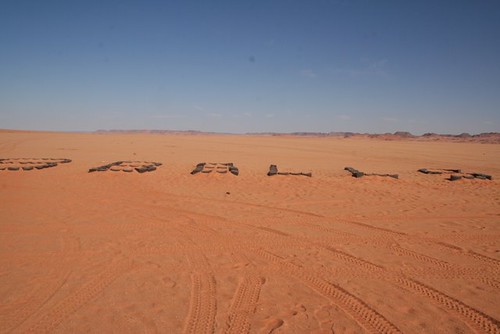
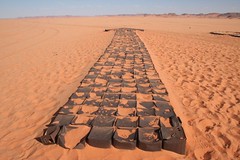
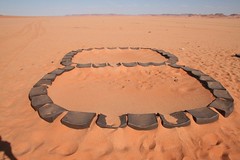
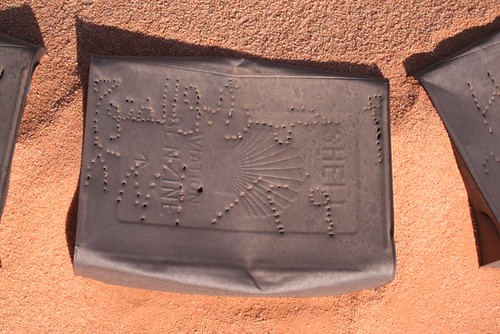 Arabic signatures and dates on the Aviation Benzene cans
Arabic signatures and dates on the Aviation Benzene cans
From the airfield we drove to Mogharet el-Qantara, also known as Shaw's Cave.
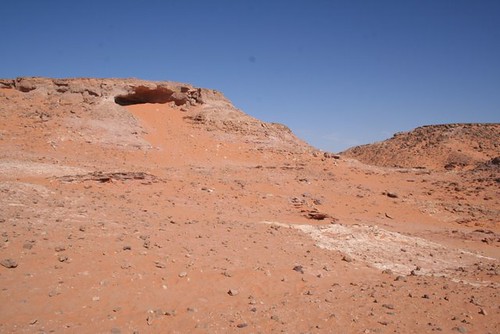
It was a steep scramble, both up the dunes for the car, and up the dune and rubble for me. I struggle with climbs - especially in soft sand. I seem to step up one step and slide back for most of it. Friendly and helpful-looking rocks on the slope were deceitful as they sat quietly waiting till I put a foot on them, then slid down the slope like sleds. One venture on a rock had me doing sideways splits while desperately clutching my precious SLR camera. Yes, I do know that I already have dust on the sensor, but I did not want any more. This meant I could not give in and crawl, but had to stay more or less vertical.
Inside, above your head and high, are marvelous paintings. I knew we would see a lot, but these were the first. I was surprised by their elegance. Black, red ochre and white they look so new and fresh that I was amazed. There was nothing tentative about these, they were strong deliberate curves and shapes, and really beautiful.
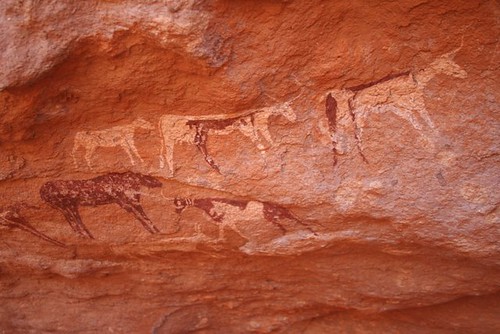
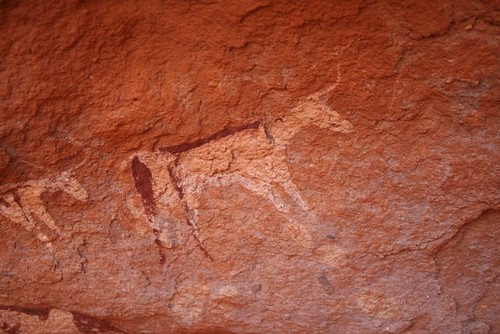
The view from inside the cave, looking down. I could imagine someone watching for game from this vantage point.
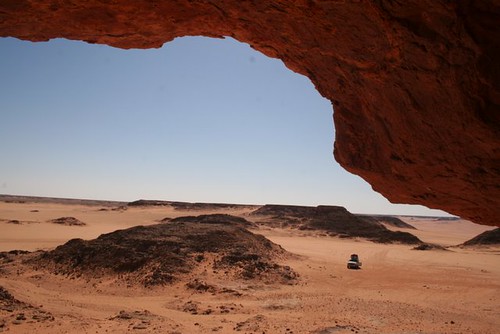
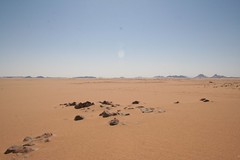
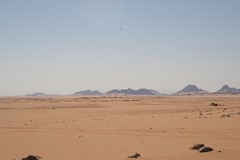
From there we crossed Wadi Firag. This is huge - a wide and long Wadi that means 'spread' and where an early explorer (was it the Hungarian Almasy? I must check) lost his guide. I photographed it from the centre looking both ways. Unusually here there are deep and well worn tracks, and we did not veer so much a a foot out of them. It was hard to understand the logic of 's' bends slavishly followed when clear short cuts over firm sand were visible - but I guess if one person had survived that way another has reason to follow. However - there is a good reason for those deep tracks. There are land mines and not many willing to risk them with a change of route.
According to local folk lore several Germans were lost a few years back and no-one has tried another way since. It reminds me of the old joke - "If at first you don't succeed, sky diving is not for you!"
I almost cried though at the tools we were passing - big heavy tools more likely to be paleolithic than neolithic. I felt as if I was just sitting there quietly whimpering.
After the wadi we headed for Peter and Paul. These were pointed out as mountains, though I note that on the map it looks like the Peter and Paul Craters.
The area is marvelous. It looks as if a giant and demented bird has strewn the area with large dark and mis-shapen eggs. They are great granite tors and have the classic granite feature of an onion-skin layering that peels away. OK - I didn't know that - but Jean Daniel told me.
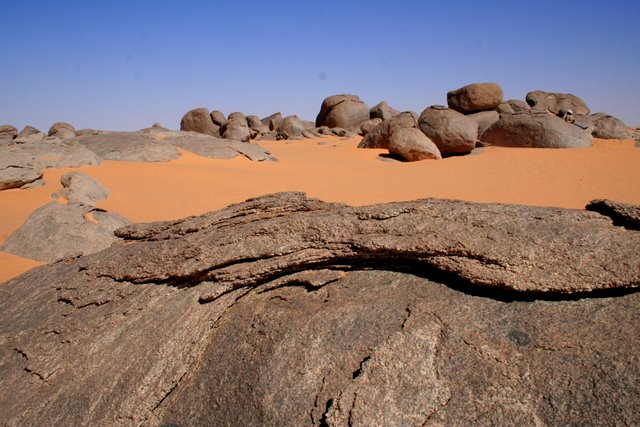
I used the site to photograph our guides and drivers - and the nice young captain, Mohamed.
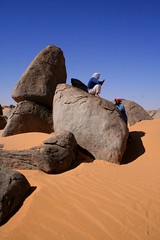
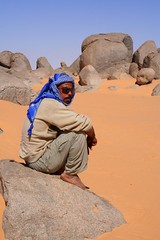
Mahmoud, our guide and leader and extraordinary cook and organiser
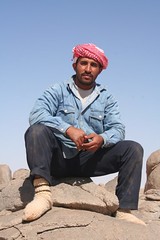 Hani, our driver and a lovely guy, with a wicked sense of humour
Hani, our driver and a lovely guy, with a wicked sense of humour
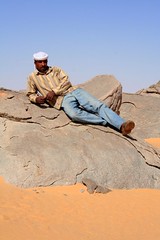 Mohamed, who drove the kitchen car and helped with everything
Mohamed, who drove the kitchen car and helped with everything
 Captain Mohamed, being a boy!
Captain Mohamed, being a boy!
 and more tors.
and more tors.
From here we swung briefly north again to a black rimmed Crater called the Clayton Craters. This was everything a crater should be - several crater systems inside a large double black rim. Unlike others we had seen this was volcanic, and the high basalt rims made with solid huge blocks of stone, rough and jagged. No obsidian - I looked - but there was quite a lot of flint and tools. Inside there were three obvious vents, each with some variations and differences in depth. It was surprisingly hot - about 37 degrees perhaps, but we walked right around the crater and climbed down the high ridge at the end.
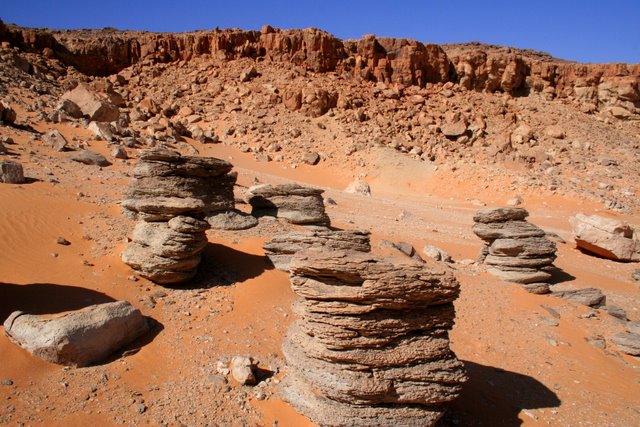

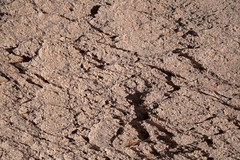
A vent and an interesting rock surface
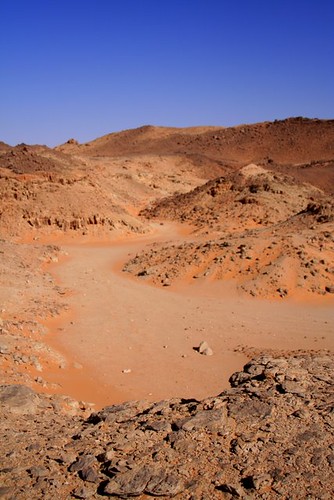
We ate lunch at the entrance of the crater. The puzzle of last night's far-too-much rice was answered - a great tuna and rice salad with chopped raw red onion, grated carrot, tomatoes, cucumbers, mayo and lots of spices. It had a real bite but tasted fantastic. We have been eating really well. The odour of overripe and rotting guava has gone now as we ate the last of it yesterday with the blackening bananas. the car was getting really pungent. It is surprising how good both were when chopped into a fruit salad with the dark jeweled seeds of four big pomegranates - just stunning. I do not think you could do it with the usual sort of banana, but oasis bananas seem to get black skins without going too soft inside - they can be utterly black and still firm and nice.
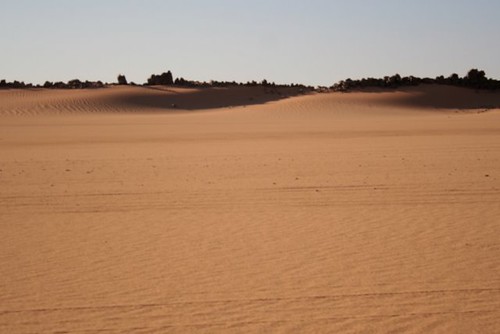 Drive-by volcanic dykes - sorry about the focus.
Drive-by volcanic dykes - sorry about the focus.
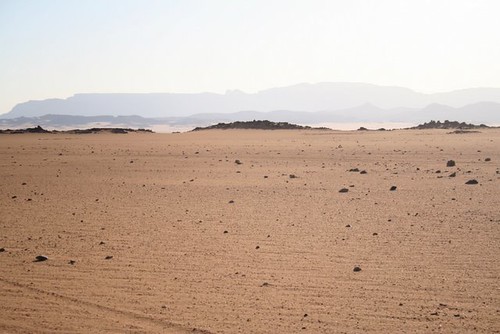
Volcanic dykes rimming the sand and the plateau of Jebel Uweinat
Briefly we lost our lead cars. We had a problem for a few minutes with the kitchen car and Hani turned back to find him. By the time we had him free of the sand the others had disappeared. there is no wind here, and we started to follow their tracks only to find that there were too many cars - clearly three in front of us - so somewhere we had picked up the wrong tracks. It is warmer this far south, and less humid too. Eventually they came back and found us but there was an annoying few minutes, and we all probably lost about half an hour.
We drove into Karkur Tal in the evening light. Mahmoud had planned one camp site, but Alberto could not get into it without four wheel drive, so we settled for an alternative. It is beautiful here, and very very different. There are trees, and insects, even flies. I had not realise d how little life we have seen. since we left the Water Mountain there has hardly been a bird. A few foxes and signs of gerbils, but that is all. Karkur Tal has fox tracks everywhere.
Driving into Karkur Tal

Acacia trees (how appropriate on Acacia and Kim's birthday!)
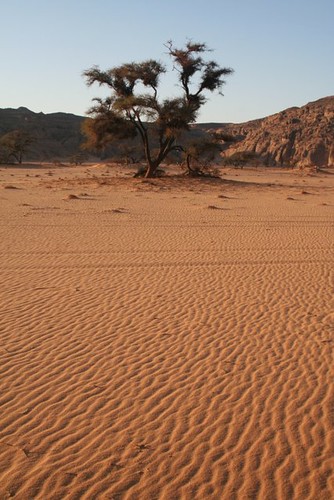
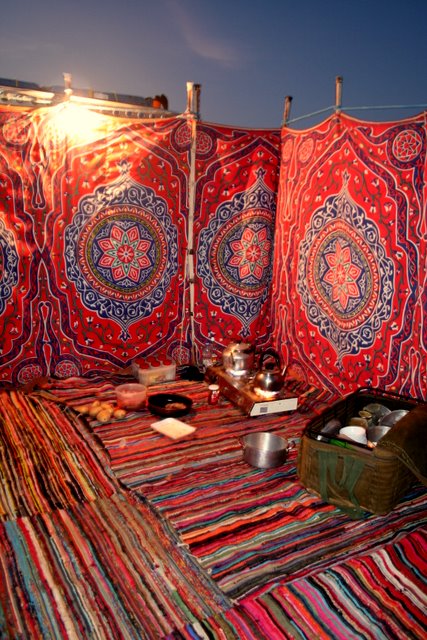
and the camp - with the kettle on and dinner cooking and the gentle spice of lentil soup scenting the air - warm and welcoming!
We rose early with a long day of travel and things to see ahead of us.
First stop was an old airport - marked out in empty drums of aviation fuel and even the name of the airport - Eight Bells - and the arrow to show the way to land had been done in old square drums. There were also food cans around - old enough as they were cans punctured on both sides of the top, not by one of those openers that makes a neat triangle, but by a jagged point. all markings were gone except those embossed into the tin, but I souvenired a can that could have been a small Campbell's soup can and it took me about an hour to shake out all the sand.



 Arabic signatures and dates on the Aviation Benzene cans
Arabic signatures and dates on the Aviation Benzene cansFrom the airfield we drove to Mogharet el-Qantara, also known as Shaw's Cave.

It was a steep scramble, both up the dunes for the car, and up the dune and rubble for me. I struggle with climbs - especially in soft sand. I seem to step up one step and slide back for most of it. Friendly and helpful-looking rocks on the slope were deceitful as they sat quietly waiting till I put a foot on them, then slid down the slope like sleds. One venture on a rock had me doing sideways splits while desperately clutching my precious SLR camera. Yes, I do know that I already have dust on the sensor, but I did not want any more. This meant I could not give in and crawl, but had to stay more or less vertical.
Inside, above your head and high, are marvelous paintings. I knew we would see a lot, but these were the first. I was surprised by their elegance. Black, red ochre and white they look so new and fresh that I was amazed. There was nothing tentative about these, they were strong deliberate curves and shapes, and really beautiful.


The view from inside the cave, looking down. I could imagine someone watching for game from this vantage point.



From there we crossed Wadi Firag. This is huge - a wide and long Wadi that means 'spread' and where an early explorer (was it the Hungarian Almasy? I must check) lost his guide. I photographed it from the centre looking both ways. Unusually here there are deep and well worn tracks, and we did not veer so much a a foot out of them. It was hard to understand the logic of 's' bends slavishly followed when clear short cuts over firm sand were visible - but I guess if one person had survived that way another has reason to follow. However - there is a good reason for those deep tracks. There are land mines and not many willing to risk them with a change of route.
According to local folk lore several Germans were lost a few years back and no-one has tried another way since. It reminds me of the old joke - "If at first you don't succeed, sky diving is not for you!"
I almost cried though at the tools we were passing - big heavy tools more likely to be paleolithic than neolithic. I felt as if I was just sitting there quietly whimpering.
After the wadi we headed for Peter and Paul. These were pointed out as mountains, though I note that on the map it looks like the Peter and Paul Craters.
The area is marvelous. It looks as if a giant and demented bird has strewn the area with large dark and mis-shapen eggs. They are great granite tors and have the classic granite feature of an onion-skin layering that peels away. OK - I didn't know that - but Jean Daniel told me.

I used the site to photograph our guides and drivers - and the nice young captain, Mohamed.


Mahmoud, our guide and leader and extraordinary cook and organiser
 Hani, our driver and a lovely guy, with a wicked sense of humour
Hani, our driver and a lovely guy, with a wicked sense of humour Mohamed, who drove the kitchen car and helped with everything
Mohamed, who drove the kitchen car and helped with everything Captain Mohamed, being a boy!
Captain Mohamed, being a boy! and more tors.
and more tors.From here we swung briefly north again to a black rimmed Crater called the Clayton Craters. This was everything a crater should be - several crater systems inside a large double black rim. Unlike others we had seen this was volcanic, and the high basalt rims made with solid huge blocks of stone, rough and jagged. No obsidian - I looked - but there was quite a lot of flint and tools. Inside there were three obvious vents, each with some variations and differences in depth. It was surprisingly hot - about 37 degrees perhaps, but we walked right around the crater and climbed down the high ridge at the end.



A vent and an interesting rock surface

We ate lunch at the entrance of the crater. The puzzle of last night's far-too-much rice was answered - a great tuna and rice salad with chopped raw red onion, grated carrot, tomatoes, cucumbers, mayo and lots of spices. It had a real bite but tasted fantastic. We have been eating really well. The odour of overripe and rotting guava has gone now as we ate the last of it yesterday with the blackening bananas. the car was getting really pungent. It is surprising how good both were when chopped into a fruit salad with the dark jeweled seeds of four big pomegranates - just stunning. I do not think you could do it with the usual sort of banana, but oasis bananas seem to get black skins without going too soft inside - they can be utterly black and still firm and nice.
 Drive-by volcanic dykes - sorry about the focus.
Drive-by volcanic dykes - sorry about the focus.
Volcanic dykes rimming the sand and the plateau of Jebel Uweinat
Briefly we lost our lead cars. We had a problem for a few minutes with the kitchen car and Hani turned back to find him. By the time we had him free of the sand the others had disappeared. there is no wind here, and we started to follow their tracks only to find that there were too many cars - clearly three in front of us - so somewhere we had picked up the wrong tracks. It is warmer this far south, and less humid too. Eventually they came back and found us but there was an annoying few minutes, and we all probably lost about half an hour.
We drove into Karkur Tal in the evening light. Mahmoud had planned one camp site, but Alberto could not get into it without four wheel drive, so we settled for an alternative. It is beautiful here, and very very different. There are trees, and insects, even flies. I had not realise d how little life we have seen. since we left the Water Mountain there has hardly been a bird. A few foxes and signs of gerbils, but that is all. Karkur Tal has fox tracks everywhere.
Driving into Karkur Tal

Acacia trees (how appropriate on Acacia and Kim's birthday!)


and the camp - with the kettle on and dinner cooking and the gentle spice of lentil soup scenting the air - warm and welcoming!


3 Comments:
Wow. Great pics. The campsite is gorgeous. much more colorful than you'd get elsewhere. mmm, lentil soup.
Jenny - as usual - you have captured the complete essence of your journey complete with mouth watering food.
Thanks for sharing it with us so we can share it in the comfort of our homes.
Jenny, How fabulous - the color is almost intoxicating, it is so rich! I imagine the color is stimulating and a direct contrast to the sandy monochromatic surrounding landscape. Jan Krentz, Poway, CA
Post a Comment
<< Home